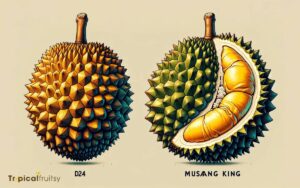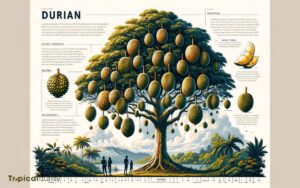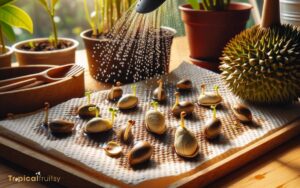Durian Bawor Vs Musang King: The Ultimate Durian Showdown!
Comparing Durian Bawor and Musang King reveals two distinctive durian varieties, each with their own flavor, origin, and market presence.
Durian Bawor, native to Indonesia, and Musang King, from Malaysia, are both celebrated for their unique taste and texture but are differentiated by their cultivation history and consumer demand.
Durian Bawor and Musang King are two types of durian fruit that differ in several aspects:
For example, Musang King durians have a deep, golden-yellow flesh with a creamy texture and a sweet, slightly bitter taste, whereas Durian Bawor’s taste and texture specifics are less globally documented due to its more recent introduction.
Discover the nuanced differences between Durian Bawor and Musang King, two titans in the world of durian delicacies.
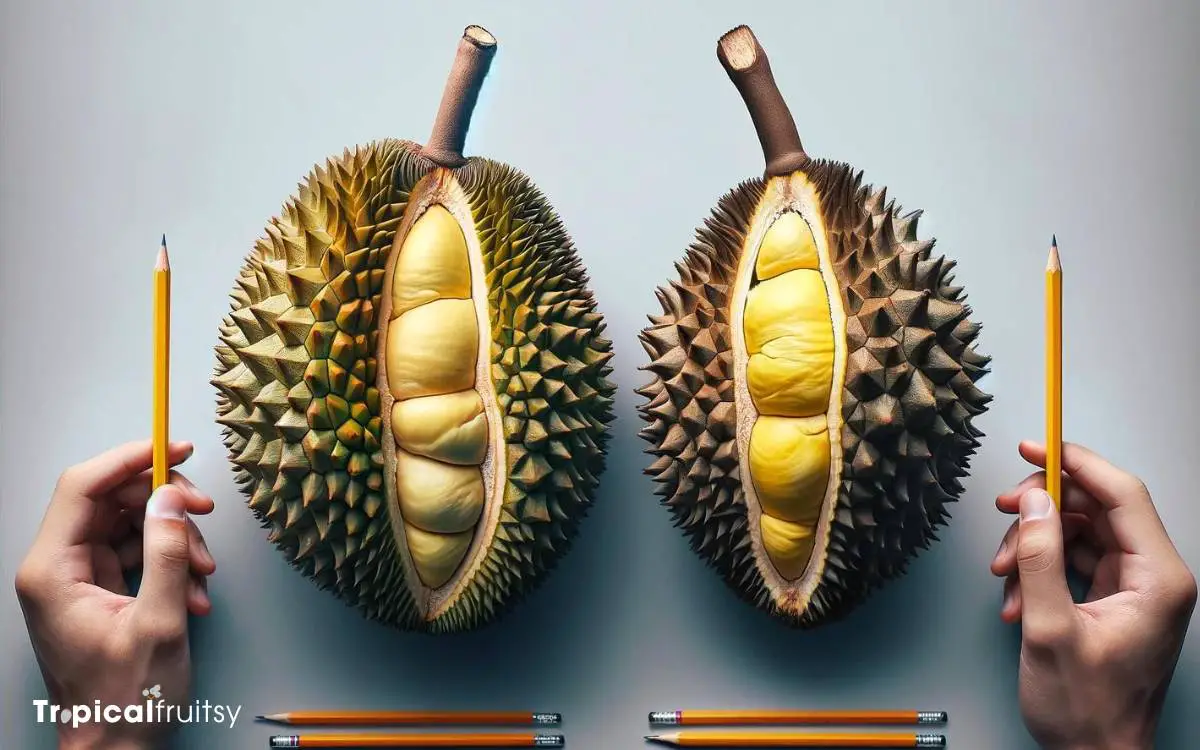
Key Takeaway
Durian Bawor vs. Musang King: A Comparative Guide
| Feature | Durian Bawor | Musang King |
|---|---|---|
| Origin | Banyumas, Central Java, Indonesia | Malaysia |
| Introduced | Recent years | Mid-20th century |
| Flesh Color | Creamy white to pale yellow | Deep, golden-yellow |
| Taste | Sweet with a hint of bitterness | Rich, sweet, and creamy with bitterness |
| Texture | Thick and creamy | Creamy and smooth |
| Market Value | Lower compared to Musang King | High, premium pricing |
| Popularity | Growing in Indonesia | Highly popular globally |
| Availability | Mainly in Indonesia | Widely available internationally |
Origin and History
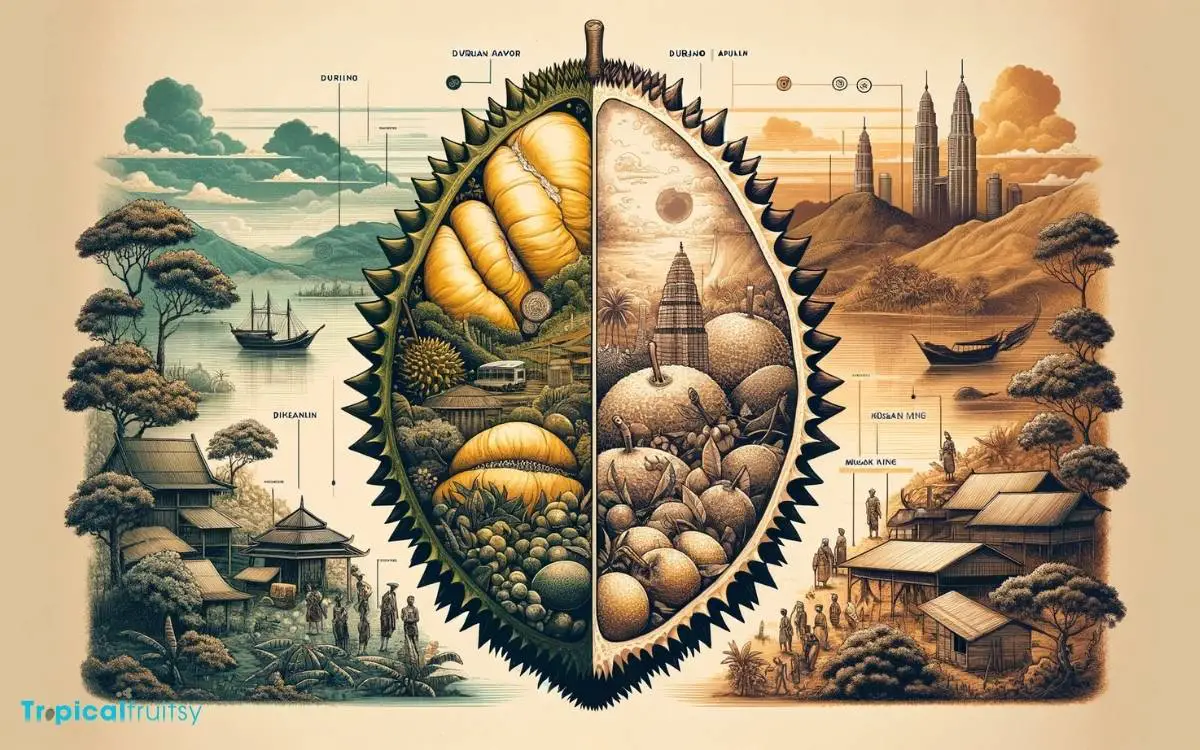
While the Durian Bawor is a relatively recent cultivar developed in Indonesia, the Musang King has a longer history of cultivation in Malaysia, dating back to the 18th century.
The Musang King, known locally as Durian Raja Kunyit, owes its origins to the Raub District of Pahang, where it was selectively bred for its distinctive traits.
This cultivar is highly valued for its creamy texture and potent aroma, qualities that have been meticulously propagated through generations.
In contrast, the Bawor variety is a product of modern agricultural practices, originating from Banyumas in Central Java. It is a hybridization effort, aiming to enhance certain durian characteristics, and it has quickly gained popularity.
This interplay of tradition and innovation sets the stage for examining their physical characteristics.
Physical Characteristics
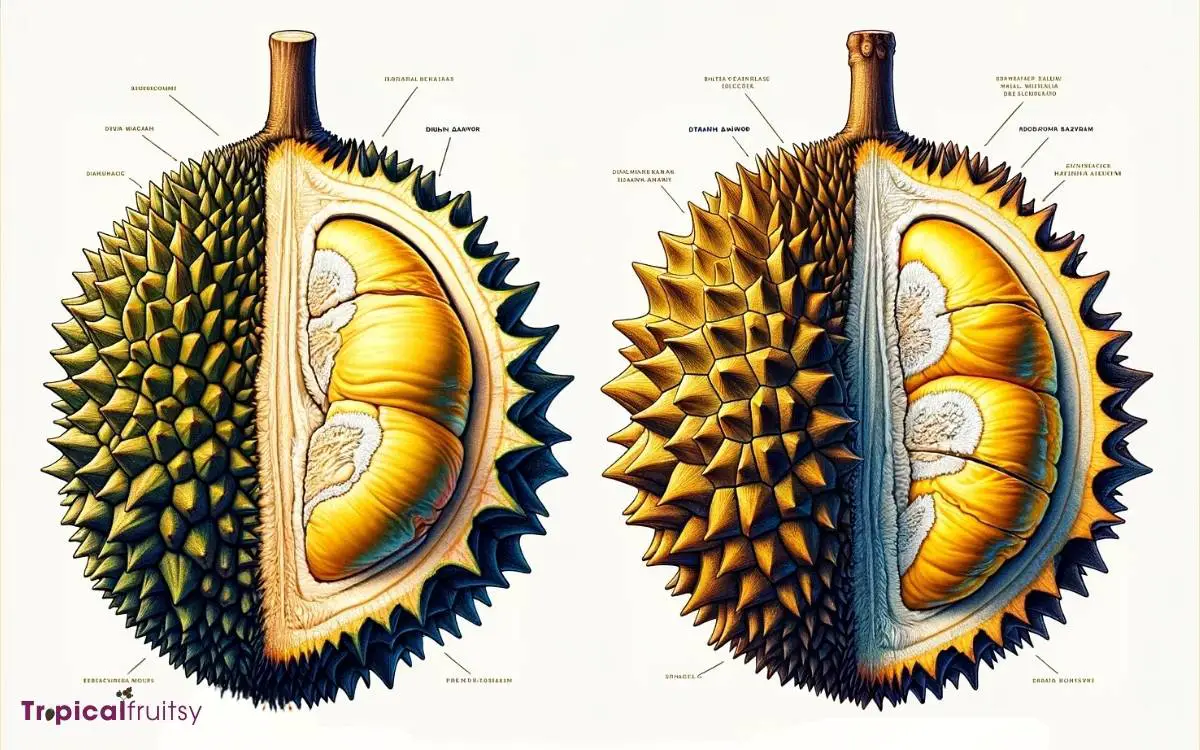
Turning our attention to the physical characteristics of Durian Bawor and Musang King, a comparative analysis reveals distinct differences in size, color, and texture that are critical for identification and consumer preference.
The Durian Bawor typically presents with a larger mass and a more pronounced oblong shape compared to the Musang King, which is renowned for its relatively uniform, rounded morphology.
Color variations between the two species are evident, with the Bawor’s husk displaying a deep green hue contrasted by the Musang King’s characteristic golden yellow tint.
Textural comparisons indicate disparities in the thorn configuration and the fruit’s inner flesh.
Size Comparison
Both Durian Bawor and Musang King exhibit distinctive size characteristics. The former generally boasts larger fruits that can weigh up to 3 kilograms each.
The Durian Bawor’s considerable size is complemented by its oblong to round shape and the presence of broad, pyramidal spikes on its husk, which contributes to its heft.
In contrast, the Musang King variety typically presents a slightly smaller profile, with average weights ranging from 1.5 to 2.5 kilograms. This species is recognized by its comparatively more uniform, rounded shape and shorter, dense thorns.
When comparing both durian varieties, it is essential to note that the size can impact marketability.
Larger fruits like the Bawor may command higher prices, whereas the more manageable Musang King sizes cater to different consumer preferences.
Color Distinctions
The hues of Durian Bawor and Musang King are notably different, with the former displaying a deep green rind and the latter characterized by a golden-yellow hue.
These chromatic variations are not merely aesthetic but serve as indicators of the cultivars’ maturity and distinct genetic makeup.
Durian Bawor’s thick, dark green shell contrasts sharply with Musang King’s vibrant, tawny exterior, which often exhibits a fine, star-shaped pattern at the base of the spikes.
Such coloration suggests differences in chlorophyll retention and carotenoid presence between the two varieties.
When assessing ripeness, the green of Bawor may turn slightly yellowish, while the Musang King’s hue intensifies. Consequently, discerning consumers utilize these visual cues to gauge the fruit’s readiness for consumption.
Texture Differences
In addition to color variations, the texture of Durian Bawor, with its firm, dense flesh, stands in stark contrast to the creamy, soft consistency characteristic of Musang King’s edible portion.
This divergence in textural properties is not merely superficial but is indicative of the intrinsic variances in their physical makeup.
- Firmness: Durian Bawor exhibits a robust structure that maintains its shape under slight pressure, while Musang King is known for its velvety texture that yields easily.
- Fiber Content: The flesh of Durian Bawor is often more fibrous, providing a chewier experience, contrary to the smooth and almost fiberless pulp of Musang King.
- Moisture Level: Musang King generally contains a higher moisture content, contributing to its custard-like feel, as opposed to the comparatively drier Bawor.
- Cellular Structure: The tighter cellular composition of Durian Bawor results in its denser mouthfeel, whereas Musang King’s looser cellularity accounts for its creamy consistency.
These characteristics are critical for consumers and cultivators alike, affecting both preference and marketability.
Flavor Profiles
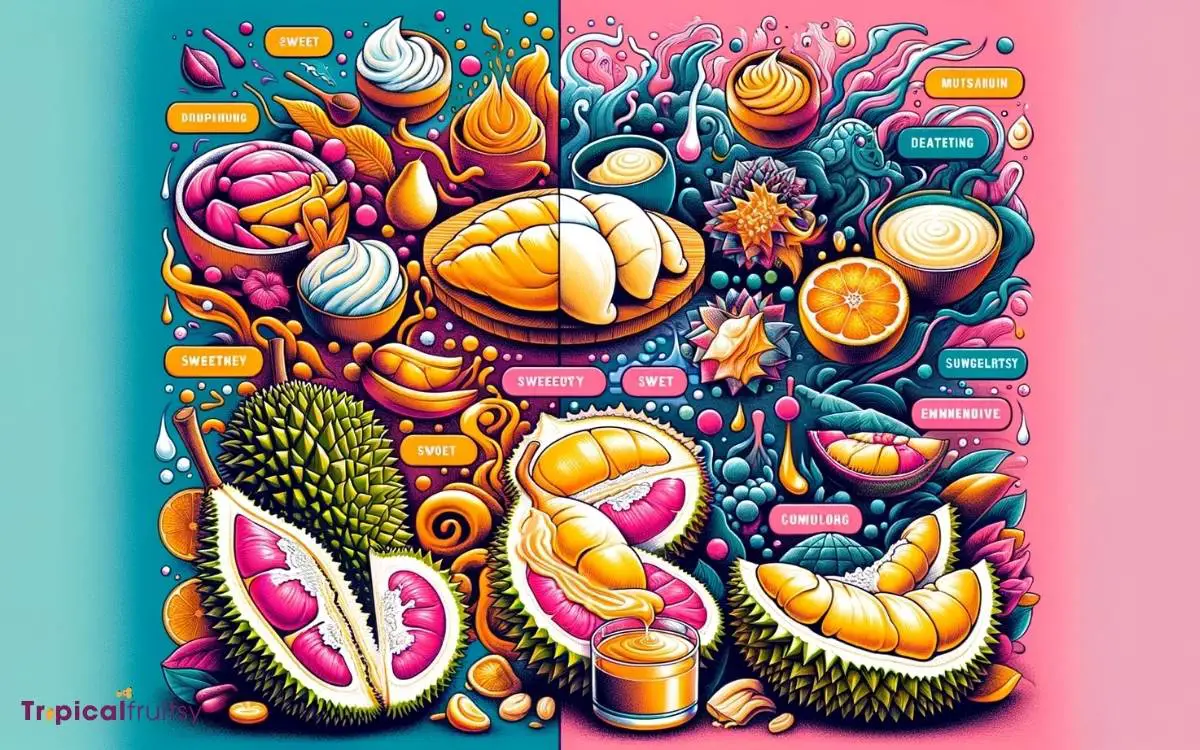
The comparison of flavor profiles between Durian Bawor and Musang King necessitates a focus on both the qualitative and quantitative aspects of taste.
Analyzing the sweetness intensity of each cultivar involves measuring the sugar content levels and understanding the complexity of flavor compounds present.
A technical assessment will reveal the nuanced variances that contribute to the overall sensory experience provided by each durian type.
Taste Comparison
Comparing the flavor profiles of Durian Bawor and Musang King reveals distinct taste nuances that distinguish these two popular varieties.
Musang King is renowned for its rich, creamy texture and a complex flavor that combines a sweet base with a subtle bitter aftertaste.
Durian Bawor, on the other hand, is often characterized by a more pronounced sweetness and a less intense bitterness, which may appeal to those who prefer a milder durian experience.
- Musang King: Pronounced sweet and bitter notes with a creamy consistency and a potent aroma.
- Durian Bawor: Dominantly sweet with minimal bitterness, offering a softer texture and a less overpowering scent.
- Texture: Musang King is silkier and denser, while Bawor is somewhat lighter.
- Aroma: Musang King carries a more robust and penetrating smell compared to the gentler fragrance of Bawor.
The analytical approach to these distinctions caters to connoisseurs seeking to understand the subtle complexities between these celebrated durians.
Sweetness Intensity
Regarding sweetness intensity within the flavor profiles of Durian Bawor and Musang King, aficionados note that Bawor typically exhibits a more pronounced sugary taste relative to the subtly less sweet yet more complex Musang King.
The Bawor variety, a cultivar from Indonesia, contains higher concentrations of natural sugars, which are discernible upon the first taste.
Its sweetness is often described as overt and immediate, appealing strongly to those with a predilection for saccharine flavors.
Conversely, the Musang King, revered in Malaysia, possesses a nuanced sweetness that is interwoven with its bittersweet notes and creamy texture.
The complexity of its flavor profile is attributable to a balanced composition of sugars, acids, and volatile compounds that contribute to its characteristic depth and lingering palate.
This multifaceted sweetness is less aggressive but more sophisticated, appealing to connoisseurs seeking a durian with intricate taste dimensions.
Nutritional Values
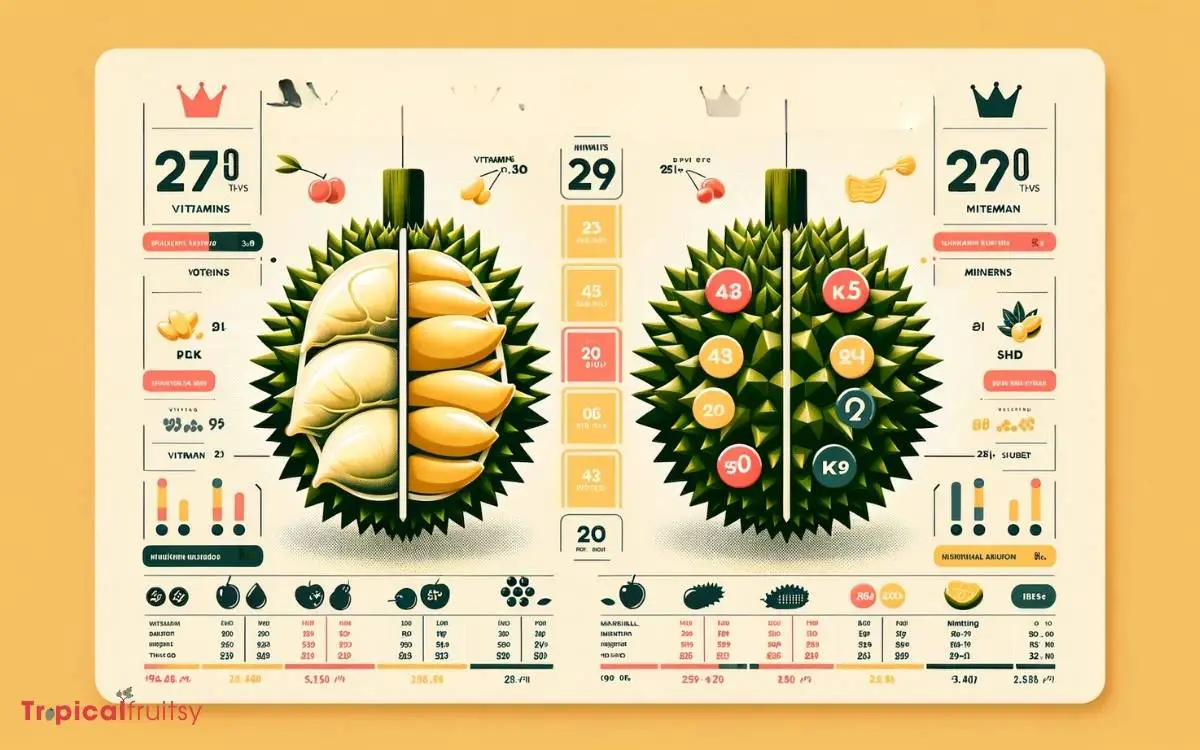
Analyzing the nutritional content of Durian Bawor and Musang King reveals subtle differences in their profiles, despite both being high in vitamins, minerals, and dietary fiber.
These distinctions, though minimal, may influence consumer preferences based on dietary needs and health considerations.
- Caloric Value: Durian Bawor often exhibits a slightly higher caloric count compared to Musang King, with variations stemming from different fat and carbohydrate concentrations.
- Vitamin Composition: Musang King typically contains a marginally increased level of Vitamin C, providing enhanced immune support.
- Mineral Density: Both varieties boast significant potassium levels, but Durian Bawor occasionally shows a superior magnesium content, crucial for muscle and nerve function.
- Fiber Content: The dietary fiber in both durians is comparable, aiding in digestive health and potentially regulating blood sugar levels.
Precise nutritional data may fluctuate based on cultivation conditions and maturation stages, necessitating a thorough analysis for accurate comparisons.
Cultivation and Harvest
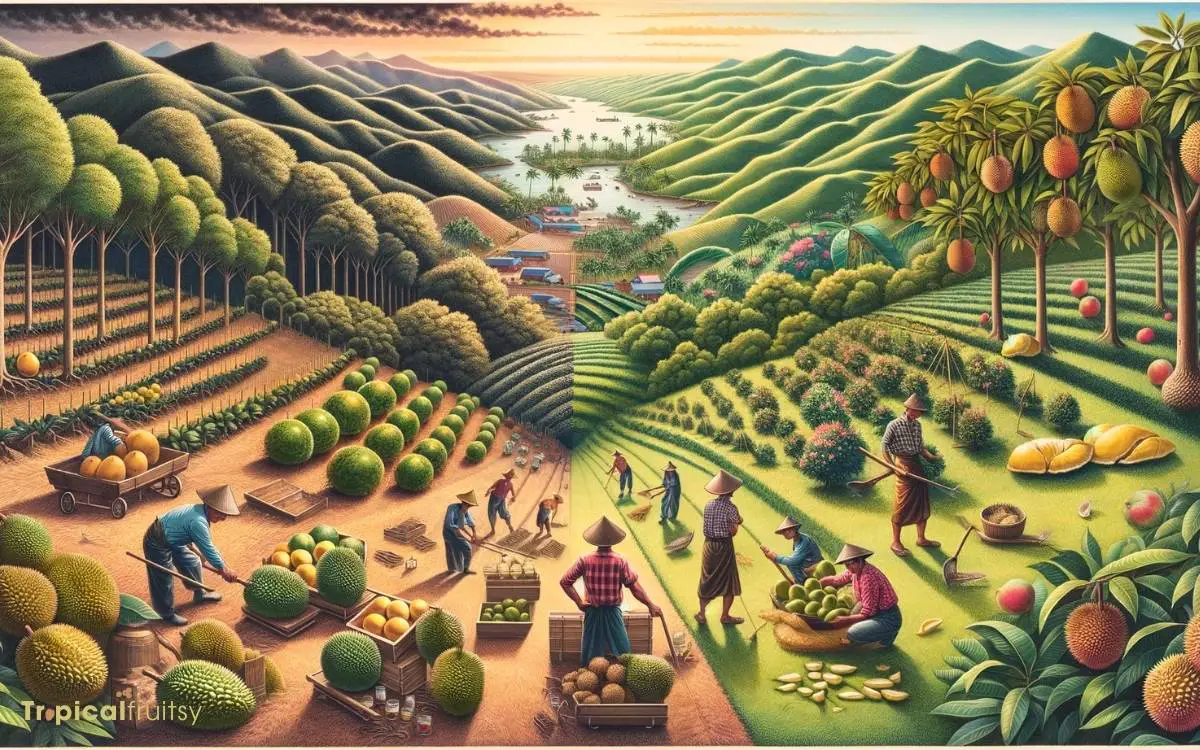
We must consider the distinct cultivation practices and harvesting techniques that set Durian Bawor and Musang King apart to understand their agricultural nuances fully.
The cultivation of Durian Bawor, primarily found in Indonesia, demands a specific microclimate and soil type, while the coveted Musang King thrives in the varied climates of Malaysia.
Harvesting practices differ, with Durian Bawor often collected after natural drop, ensuring peak ripeness, versus Musang King, which may be cut from the tree to manage the exact harvest time and quality control.
| Aspect | Durian Bawor | Musang King |
|---|---|---|
| Climate Preference | Specific microclimate, high humidity | Tolerant to varied climates |
| Soil Requirement | Fertile, well-drained volcanic soil | Requires deep, fertile, well-drained soil |
| Harvesting Technique | Natural drop indicates ripeness | May be cut before natural drop for quality control |
Popularity and Availability

The popularity and availability of Durian Bawor and Musang King vary significantly due to their geographical origins and consumer demand.
Musang King, hailing from Malaysia, has earned a renowned status globally, particularly in China, where its demand has led to increased exports.
Conversely, Durian Bawor, originating from Indonesia, remains a local delicacy with a growing but more contained following.
- Geographical Distribution: Musang King is widely cultivated in Malaysia and has a robust export market, whereas Durian Bawor is predominantly found in Indonesia.
- Market Presence: Musang King has a dominant international presence, especially in East Asia, compared to Bawor’s nascent export activity.
- Consumer Demand: Musang King’s fame has spiked its demand, making it more accessible in various regions.
- Cultivation Expansion: Efforts to scale Musang King cultivation are notable, unlike the more regionally confined Bawor farms.
Price Comparison and Value

Although Durian Bawor is generally less expensive than Musang King, the latter’s higher price point is often justified by its international acclaim and demand.
Musang King durians command premium pricing due to their consistent quality attributes, such as creamy texture, intense flavor profile, and vibrant golden-yellow flesh.
From an economic perspective, the supply chain for Musang King is extensive, with established export markets that amplify its cost.
Conversely, Durian Bawor, primarily cultivated in smaller farms within its native region, incurs lower distribution and marketing costs. Its price is reflective of a more localized market, with fewer intermediaries between production and consumer.
Analyzing the value proposition, Musang King’s price includes factors such as global shipping, stringent quality control, and branding, whereas Durian Bawor offers a more cost-effective option for those within its regional availability.
Conclusion
In the realm of durian cultivars, Durian Bawor and Musang King reign supreme, each offering a unique gustatory experience.
The former, a pride of Indonesia, and the latter, a Malaysian treasure, have carved distinct niches in the global market.
Despite their divergent origins and sensory profiles, both varieties command a king’s ransom, with Musang King often fetching astronomical prices.
The fervor surrounding these durian cultivars underscores their status as the undisputed monarchs of the fruit world.




